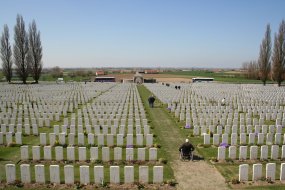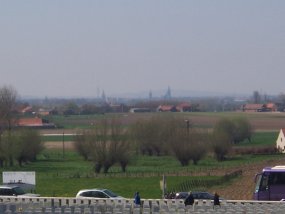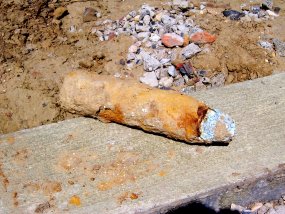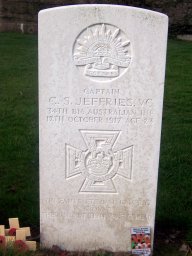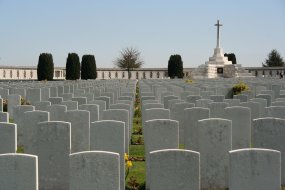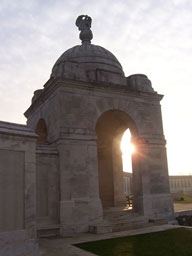
WWII: Maginot Line | Normandy | V-Weapon Sites | Arnhem
Further afield: Crete
| Home Tracing Military Ancestors Travel Advice CWGC Cemeteries Iron Harvest News Book Reviews Glossary Links Contact Me Ypres:
 
|
Core Location 7 – Tyne Cot CWGC, Passendale
Directions – From Vancouver Corner continue into Zonnebeke and take the last exit from the roundabout by the church towards Passendale. This is the ground so bitterly contested during Third Ypres as the British tried desperately to reach the top of the Passchendaele Ridge. Take the last exit at the next roundabout and take the second turning on the left. The road leads up to Tyne Cot CWGC Cemetery. Practical Information – Tyne Cot is one of the top sites for visitors in the entire Salient. As such it is usually packed with school parties, minibus tours and private vehicles. In fact the upsurge in visitors has been so great in the last 5 years that, in 2006, the local authorities built a car park to the rear of the cemetery to ease congestion, together with a Visitor's Centre. Early morning and early evening are less crowded and you may wish to skip this location, carry on the tour of the central and southern parts of the battlefield and then return later in the day. Historical Notes – Tyne Cot CWGC Cemetery is, quite simply, the largest Commonwealth war cemetery anywhere in the world. Its 11,871 burials comprise 8,901 UK, 1,353 Australian, 966 Canadian, 519 New Zealand, 14 Newfoundland, 6 Guernsey, 4 German and 2 British West Indies. Seventy per cent are unknown. On the engraved panels at the rear of the cemetery are the names of a further 35,000 who have no known grave. Most were killed during the Third Battle of Ypres, the Passchendaele offensive. During the battle, soldiers of the Northumberland Fusiliers thought the German bunkers in this area resembled the rows of cottages back in their native Tyneside. The spot quickly became known as Tyneside Cottages or Tyne Cot. Five of these bunkers remain within the cemetery grounds. Two can be seen in the lower part of the cemetery flanked by tall trees. A third is located under the Cross of Sacrifice – a suggestion of King George V when he visited during construction in May 1922. Two more lie buried under the plots in the upper reaches of the cemetery. Tyne Cot was originally used as a battlefield burial ground during the fighting and the untidily spaced graves from this period can be easily spotted behind the Cross of Sacrifice. After the war, remains were brought in from isolated locations in other parts of the Salient to form the huge concentration seen today. The Memorial to the Missing at the rear contains names of British soldiers killed in the Salient from 16th August 1917 until the end of the war that have no known grave together with all the unknown New Zealanders killed in the Salient during the entire war.
Getting Your Bearings – As you look from the Cross of Sacrifice across the serried ranks of headstones to the countryside beyond the road you are looking across the battlefield of Third Ypres. In the distance on a clear day you should be able to pick out the spire of St Martin’s Cathedral and the tower of the Cloth Hall in Ieper. The British would have been attacking up the slope towards you. About 2 km beyond the back wall of the cemetery is Passchendaele village – the top of the Passchendaele Ridge and the British objective. Eyewitness Account – Looking out over the neat farmland today it is difficult to picture the scene as it looked during Third Ypres. In his book, “Warrior”, Lt-Col G.S. Hutchinson paints a vivid picture of the conditions and the men who fought in them, which is worth quoting at length: “At Tyne Cot I would dive through the soaking heavy blanket and descend to flickering light bound by solid concrete. Great shadows fluttered on the roof and walls. The air was stuffy with coke fumes, soggy clothing, and unwashed humanity. It smote me unpleasantly as I came from the freshness of the night air, albeit tainted with the fumes of gas and rotting corpses. Extract taken from Flanders Then & Now, The Ypres Salient and Passchendaele by John Giles, Battle of Britain Prints International Ltd 1995.
It is often mistakenly assumed that only the British and Commonwealth soldiers endured the suffering of Third Ypres. However, the Germans had to bear the same conditions and dangers. The following extract from the 92nd Infantry’s Regimental History describes a British bombardment striking their positions in the Passchendaele sector in October 1917: "...they hope, to sell their lives as dearly as possible. This weakness is frightful. Their face is distorted in grim rage. The fist firmly holds the rifle. All too often the weapons are choked up and became useless. Each repairs them with feverish haste. The eyes attempted to see through the haze, the ears strained to listen, banishing the danger by the sudden appearance of the enemy in front of them. The enemy’s batteries drummed further. All the minenwerfers [mortars] were buried and the machine guns, for the greater part, suffered a similar fate. A soldier, according to the extent of his wounds, was placed to the side or rolled into the craters. Life was slowly, sluggishly, fleeing out of the wounds. No wild pain. They felt the fullest fulfilment of their life as they died, from which the beginning had been death in battle. With parched lips and burning sight the living still waited, crouched between the dead and the wounded." Extract taken from Passchendaele The Fight for the Village by Nigel Cave, Leo Cooper 1997. |
||||||||

